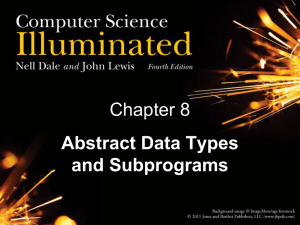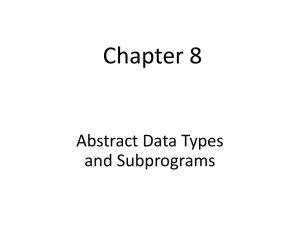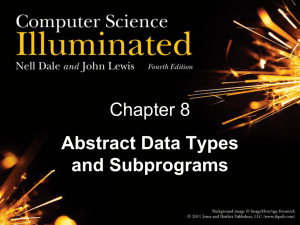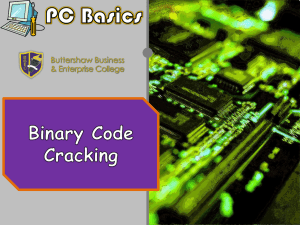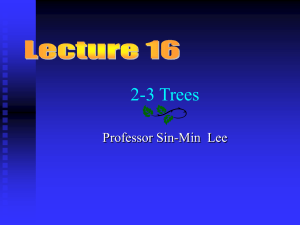Chapter 8
advertisement
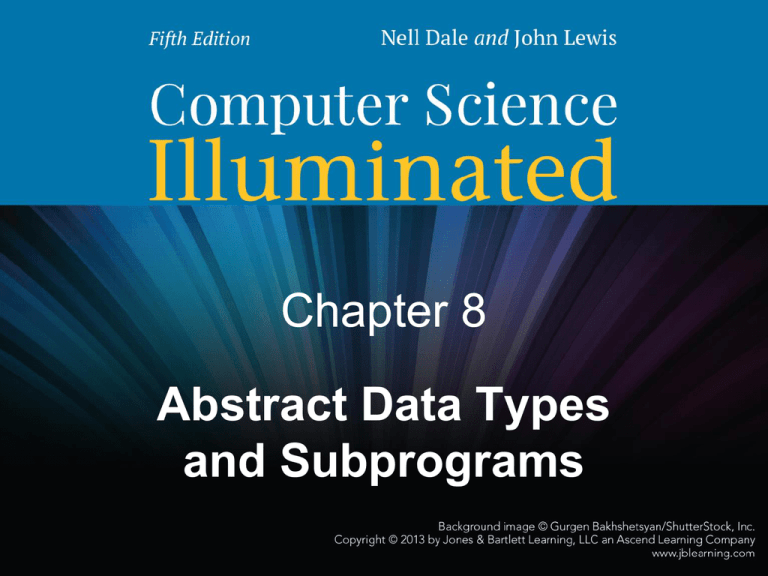
Chapter 8 Abstract Data Types and Subprograms Chapter Goals • Distinguish between an array-based visualization and a linked visualization • Distinguish between an array and a list • Distinguish between and a unsorted list and a sorted list • Distinguish between the behavior of a stack and a queue • Distinguish between the binary tree and a binary search tree 2 Chapter Goals • Draw the binary search tree that is built from inserting a series of items • Understand the difference between a tree and a graph • Explain the concept of subprograms and parameters and distinguish between value and reference parameters 3 Abstract Data Types Abstract data type A data type whose properties (data and operations) are specified independently of any particular implementation Remember what the most powerful tool is for managing complexity? 4 Three Views of Data Application (user) level View of the data within a particular problem View sees data objects in terms of properties and behaviors 5 Three Views of Data Logical (abstract) level Abstract view of the data and the set of operations to manipulate them View sees data objects as groups of objects with similar properties and behaviors 6 Three Views of Data Implementation level A specific representation of the structure that hold the data items and the coding of the operations in a programming language View sees the properties represented as specific data fields and behaviors represented as methods implemented in code 7 Three Views of Data Describe a word processor from the three views 8 Three Views of Data Composite data type A data type in which a name is given to a collection of data values Data structures The implementation of composite data fields in an abstract data type Containers Object’s whole role is to hold and manipulate other objects 9 Logical Implementations Two logical implementations of containers: Array-based implementation Objects in the container are kept in an array Linked-based implementation Objects in the container are not kept physically together, but each item tells you where to go to get the next one in the structure Did you ever play treasure hunt, a game in which each clue told you where to go to get the next clue? 10 Stacks Stack An abstract data type in which accesses are made at only one end – LIFO, which stands for Last In First Out – The insert is called Push and the delete is called Pop Name three everyday structures that are stacks 11 Stacks WHILE (more data) Read value Push(myStack, value) WHILE (NOT IsEmpty(myStack)) Pop(myStack, value) Write value Can you hand simulate this algorithm? 12 Queues Queue An abstract data type in which items are entered at one end and removed from the other end – FIFO, for First In First Out – No standard queue terminology • Enqueue, Enque, Enq, Enter, and Insert are used for the insertion operation • Dequeue, Deque, Deq, Delete, and Remove are used for the deletion operation. 13 Name three everyday structures that are queues Queues WHILE (more data) Read value Enque(myQueue, value) WHILE (NOT IsEmpty(myQueue)) Deque(myQueue, value) Write value Can you hand simulate this algorithm? Stacks and Queues Stack and queue visualized as linked structures 15 Lists Think of a list as a container of items Here are the logical operations that can be applied to lists Add item Remove item Get next item more items 16 Put an item into the list Remove an item from the list Get (look) at the next item Are there more items? Array-Based Implementations 17 Linked Implementations 18 Algorithm for Creating and Print Items in a List WHILE (more data) Read value Insert(myList, value) Reset(myList) Write "Items in the list are " WHILE (moreItems(myList)) GetNext(myList, nextItem) Write nextItem, ' ' Which implementation? 19 Logical Level The algorithm that uses the list does not need to know how it is implemented We have written algorithms using a stack, a queue, and a list without ever knowing the internal workings of the operations on these containers 20 Trees Structure such as lists, stacks, and queues are linear in nature; only one relationship is being modeled More complex relationships require more complex structures Can you name three more complex relationships? 21 Trees Binary tree A linked container with a unique starting node called the root, in which each node is capable of having two child nodes, and in which a unique path (series of nodes) exists from the root to every other node A picture is worth a thousands words… 22 Trees Root node Node with two children Node with right child Leaf node Node with left child 23 What is the unique path to the node containing 5? 9? 7? … Binary Search Trees Binary search tree (BST) A binary tree (shape property) that has the (semantic) property that characterizes the values in a node of a tree: The value in any node is greater than the value in any node in its left subtree and less than the value in any node in its right subtree 24 Binary Search Tree Each node is the root of a subtree made up of its left and right children Prove that this tree is a BST Figure 8.7 A binary search tree 25 Binary Search Tree 26 Binary Search Tree Boolean IsThere(current, item) If (current is null) return false Else Set result to item.compareTo(info(current)) If (result is equal to 0) return true Else If (result < 0) IsThere(item, left(current)) Else IsThere(item, right(current)) 27 Binary Search Tree Trace the nodes passed as you search for 18, 8, 5, 4, 9, and 15 What is special about where you are when you find null? 28 Binary Search Tree IsThere(tree, item) IF (tree is null) RETURN FALSE ELSE IF (item equals info(tree)) RETURN TRUE ELSE IF (item < info(tree)) IsThere(left(tree), item) ELSE IsThere(right(tree), item) 29 Building Binary Search Tree 30 Building Binary Search Tree Insert(tree, item) IF (tree is null) Put item in tree ELSE IF (item < info(tree)) Insert (left(tree), item) ELSE Insert (right(tree), item) 31 Binary Search Tree Print(tree) If (tree is not null) Print (left(tree)) Write info(tree) Print (right(tree)) Is that all there is to it? Yes! Remember we said that recursive algorithms could be very powerful! 32 Graphs Graph A data structure that consists of a set of nodes (called vertices) and a set of edges that relate the nodes to each other Undirected graph A graph in which the edges have no direction Directed graph (Digraph) A graph in which each edge is directed from one vertex to another (or the same) vertex 33 Graphs Figure 8.10 Examples of graphs 34 Graphs Figure 8.10 Examples of graphs 35 Graphs Figure 8.10 Examples of graphs 36 Graph Algorithms A Depth-First Searching Algorithm--Given a starting vertex and an ending vertex, we can develop an algorithm that finds a path from startVertex to endVertex This is called a depth-first search because we start at a given vertex and go to the deepest branch and explore as far down one path before taking alternative choices at earlier branches 37 Depth First Search(startVertex, endVertex) Set found to FALSE Push(myStack, startVertex) WHILE (NOT IsEmpty(myStack) AND NOT found) Pop(myStack, tempVertex) IF (tempVertex equals endVertex) Write endVertex Set found to TRUE ELSE IF (tempVertex not visited) Write tempVertex Push all unvisited vertexes adjacent with tempVertex Mark tempVertex as visited IF (found) Write "Path has been printed" ELSE Write "Path does not exist") 38 Can we get from Austin to Washington? Figure 8.11 Using a stack to store the routes 39 Can we get from Austin to Washington? Figure 8.12, The depth-first search 40 Breadth-First Search What if we want to answer the question of how to get from City X to City Y with the fewest number of airline stops? A Breadth-First Search answers this question A Breadth-First Search examines all of the vertices adjacent with startVertex before looking at those adjacent with those adjacent to these vertices A Breadth-First Search uses a queue, not a stack, to answer this above question Why?? 41 Breadth First Search(startVertex, endVertex) Set found to FALSE Enque(myQueue, startVertex) WHILE (NOT IsEmpty(myQueue) AND NOT found) Deque(myQueue, tempVertex) IF (tempVertex equals endVertex) Write endVertex Set found to TRUE ELSE IF (tempVertex not visited) Write tempVertex Enque all unvisited vertexes adjacent with tempVertex Mark tempVertex as visited IF (found) Write "Path has been printed" ELSE Write "Path does not exist" How can I get from Austin to Washington in the fewest number of stops? Figure 8.13 Using a queue to store the routes 43 Breadth-First Search Traveling from Austin to Washington, DC Figure 8.14, The Breadth-First Search 44 Subprogram Statements We can give a section of code a name and use that name as a statement in another part of the program When the name is encountered, the processing in the other part of the program halts while the named code is executed Remember? 45 Subprogram Statements What if the subprogram needs data from the calling unit? Parameters Identifiers listed in parentheses beside the subprogram declaration; sometimes called formal parameters Arguments Identifiers listed in parentheses on the subprogram call; sometimes called actual parameters 46 Subprogram Statements Value parameter A parameter that expects a copy of its argument to be passed by the calling unit Reference parameter A parameter that expects the address of its argument to be passed by the calling unit 47 Subprogram Statements Think of arguments as being placed on a message board 48 Subprogram Statements Insert(list, item) // Subprogram definition Set list.values[length-1] to item Set list.length to list.length + 1 Insert(myList, value) // Calling statement Which parameter must be by reference? 49 Ethical Issues Workplace Monitoring Do privacy rights extend to the workplace? What is employee Internet monitoring? Have you been monitored in the workplace? How is email equivalent to DNA? 50 Who am I? In the 1940s, the new computer architecture I developed revolutionized the design of computers. Today’s computers are referred to as [my last name] machines because the architectural principles I described have proven very successful. Courtesy of the U.S. Department of Energy. 51 Do you know? What is peer-to-peer funding? What is an EAN message? How did the 2007 Economic Stimulus Package provide a feast day for scammer? What is the difference between a hacker and a cracker? 52
